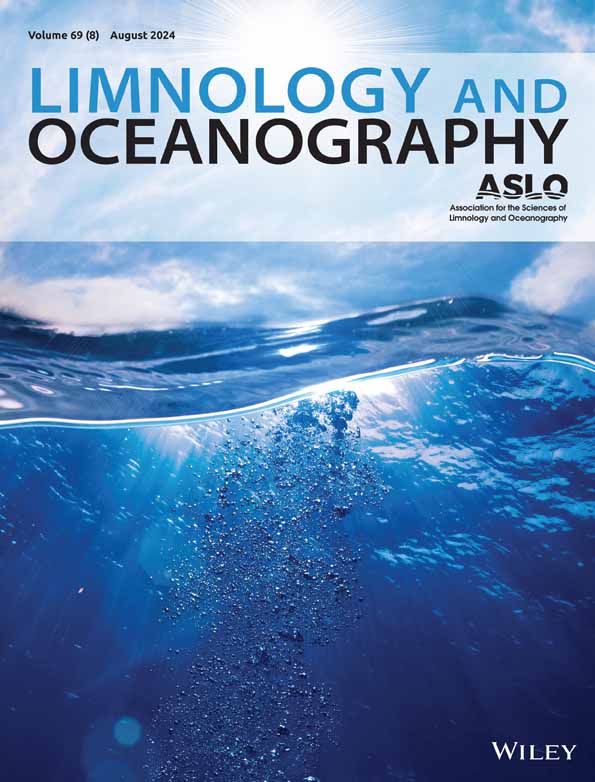气候变化对海洋群岛上升流和浅礁营养源的影响
IF 3.7
1区 地球科学
Q1 LIMNOLOGY
引用次数: 0
摘要
上升流为珊瑚礁群落提供了关键的营养和能量补贴,影响了整个营养水平的生物的生长、丰度和生态。然而,许多珊瑚礁局部上升流的跨尺度海洋学和大气驱动因素仍未得到解决,这限制了我们预测气候变化如何破坏上升流模式并影响跨地域珊瑚礁群落的能力。利用18个月收集的高时间分辨率(10秒)现场温度测量数据,包括本世纪最强的印度洋正偶极子相,我们证明了气候驱动的混合层深度对查戈斯群岛纬向范围(~ 200公里)上升流强度的高度非线性影响。当混合层深度小于~ 40 m时,浅层(10 ~ 25 m)珊瑚礁群落对较深上升流的暴露最大,而当混合层深度大于~ 60 m时,几乎没有暴露。通过将这些温度数据与一种常见大型藻类的氮稳定同位素(δ15N)相结合,我们发现上升流的这些变化与营养来源的改变有关,这些变化对整个群岛的珊瑚礁生物有直接可测量的影响。我们进一步表明,在过去的40年里,印度洋偶极子的正相位与这些珊瑚礁上异常深的表面混合层相关,每次都可能限制上升流。鉴于这些极端事件在气候变化的影响下频率越来越高,这可能会在未来一个世纪出现一个明显不同的群岛上升流制度,其生态后果目前尚不清楚。本文章由计算机程序翻译,如有差异,请以英文原文为准。
Climate change impacts to upwelling and shallow reef nutrient sources across an oceanic archipelago
Upwelling delivers key nutritional and energetic subsidies to coral reef communities that affect the growth, abundance, and ecology of organisms across trophic levels. However, the cross‐scale oceanographic and atmospheric drivers of localized upwelling on many reefs remain unresolved, limiting our ability to predict how climate change might disrupt upwelling patterns and impact reef communities across geographies. Using high temporal resolution (10 second) in situ temperature measurements collected over 18 months that encompassed the strongest positive Indian Ocean Dipole phase of this century, we demonstrate a highly nonlinear effect of climate‐driven mixed layer depth on upwelling intensity across the latitudinal range of the Chagos Archipelago (~ 200 km). The exposure of shallow (10–25 m depth) reef communities to deeper upwelled waters was maximized when the mixed layer depth was shallower than ~ 40 m, but virtually absent when the mixed layer depth was deeper than ~ 60 m. By combining these temperature data with nitrogen stable isotopes (δ15 N) from a common macroalga, we show these variations in upwelling correlate with altered nutrient sources that have direct measurable impacts on reef organisms across the Archipelago. We further show that over the past 40 years, positive phases of the Indian Ocean Dipole correlate with an anomalously deep surface mixed layer on these reefs, each time likely restricting upwelling. Given these extreme events are increasing in frequency under climate change, this poses the possibility of a markedly different upwelling regime across the Archipelago over the coming century, with currently unknown ecological consequences.
求助全文
通过发布文献求助,成功后即可免费获取论文全文。
去求助
来源期刊

Limnology and Oceanography
地学-海洋学
CiteScore
8.80
自引率
6.70%
发文量
254
审稿时长
3 months
期刊介绍:
Limnology and Oceanography (L&O; print ISSN 0024-3590, online ISSN 1939-5590) publishes original articles, including scholarly reviews, about all aspects of limnology and oceanography. The journal''s unifying theme is the understanding of aquatic systems. Submissions are judged on the originality of their data, interpretations, and ideas, and on the degree to which they can be generalized beyond the particular aquatic system examined. Laboratory and modeling studies must demonstrate relevance to field environments; typically this means that they are bolstered by substantial "real-world" data. Few purely theoretical or purely empirical papers are accepted for review.
 求助内容:
求助内容: 应助结果提醒方式:
应助结果提醒方式:


